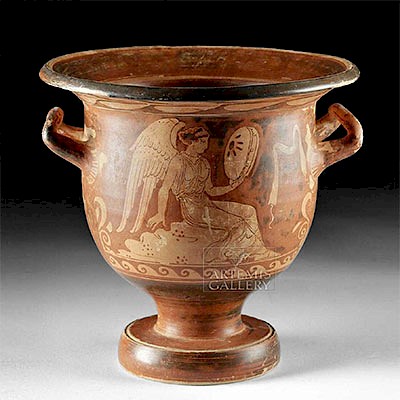Massive Olmec Olivine-Serpentine Celt
Lot 158
About Seller
Artemis Gallery
686 S Taylor Ave, Ste 106
Louisville, CO 80027
United States
Selling antiquities, ancient and ethnographic art online since 1993, Artemis Gallery specializes in Classical Antiquities (Egyptian, Greek, Roman, Near Eastern), Asian, Pre-Columbian, African / Tribal / Oceanographic art. Our extensive inventory includes pottery, stone, metal, wood, glass and textil...Read more
Estimate:
$3,000 - $4,500
Absentee vs Live bid
Two ways to bid:
- Leave a max absentee bid and the platform will bid on your behalf up to your maximum bid during the live auction.
- Bid live during the auction and your bids will be submitted real-time to the auctioneer.
Bid Increments
| Price | Bid Increment |
|---|---|
| $0 | $25 |
| $300 | $50 |
| $1,000 | $100 |
| $2,000 | $250 |
| $5,000 | $500 |
| $10,000 | $1,000 |
| $20,000 | $2,500 |
| $50,000 | $5,000 |
| $100,000 | $10,000 |
| $200,000 | $20,000 |
About Auction
By Artemis Gallery
Mar 7, 2019
Set Reminder
2019-03-07 10:00:00
2019-03-07 10:00:00
America/New_York
Bidsquare
Bidsquare : VARIETY SALE | Antiquities & Ethnographic Art
https://www.bidsquare.com/auctions/artemis-gallery/variety-sale-antiquities-ethnographic-art-3928
Around the world & back in time - be amazed at the treasures you will find. Antiquities from Egypt, Greece, Italy and the Near East, Asian, Pre-Columbian, African / Tribal / Oceanic, Native American, Spanish Colonial, Russian Icons, Fine Art, much more! Artemis Gallery info@artemisgallery.com
Around the world & back in time - be amazed at the treasures you will find. Antiquities from Egypt, Greece, Italy and the Near East, Asian, Pre-Columbian, African / Tribal / Oceanic, Native American, Spanish Colonial, Russian Icons, Fine Art, much more! Artemis Gallery info@artemisgallery.com
- Lot Description
Pre-Columbian, Southern Mexico to Guatemala, Olmec culture, ca. 1150 to 550 BCE. An absolutely enormous, hand-carved mottled olivine-serpentine celt with light and dark inclusions, presenting a tapered conical handle, a gradually-expanding body, a smooth exterior, and rounded blade faces with an acutely-angled edge. The olivine-serpentine stone itself exhibits areas of green, blue-green, and black color, giving it an elegant presentation. The celt is a tapered hand tool of a highly-stylized ritual form with an overall ovoid form and a curved blade. Meticulously flaked and then sanded to a smooth, reflective sheen, this is a stunning piece of art, designed to resemble a common weapon but used for a votive function, probably carried in a ceremony and/or buried with its owner. Lucite display stand for photography purposes only. Size: 4.375" W x 9.5" H (11.1 cm x 24.1 cm).
Olmec artisans used long distance trade routes to acquire greenstone like this from Eastern Guatemala, over three hundred miles from their homeland. All of this speaks to its immense value in society. Green stones seem to have been associated with water, vegetation, and young corn, the staple food of Olmec life. Recent scholarship has linked the embrace of green serpentine by the Olmec to the importance of corn in the Olmec economy as greenstone along with quetzal plumes symbolized verdant maize, a most valuable staple, to the indigenous peoples. In fact, greenstone celts like this example symbolized ears of corn and were used as a form of currency by the Olmec (Karl A. Taube, Olmec Art at Dumbarton Oaks, 1996, p. 18). Based on burial practices, particularly the objects from important burials at La Venta in the present day Mexican state of Tabasco, we believe that green stone was reserved for high nobility, royalty, and the gods.
This item is an exemplar of ancient Mesoamerican sculpture, impressive for its technique, iconography, and well as the inherent beauty of ancient stone-working. A superb sculptural work from the Olmec, indeed the first Mesoamerican civilization that most regard as the forerunner of subsequent ancient American cultures such as the Maya and Aztecs!
Provenance: private Los Angeles County, California, USA collection, since 1985
All items legal to buy/sell under U.S. Statute covering cultural patrimony Code 2600, CHAPTER 14, and are guaranteed to be as described or your money back.
A Certificate of Authenticity will accompany all winning bids.
We ship worldwide and handle all shipping in-house for your convenience.
#135327Repairs to tip of handle and large section of blade edge with some light adhesive residue and overpainting along break lines. Surface wear and abrasions commensurate with age as expected, small nicks to bottom of handle, and some old sticker residue on one face. Light earthen deposits throughout.Condition
- Shipping Info
-
All shipping is handled in-house for your convenience. Your invoice from Artemis Gallery will include shipping calculation instructions. If in doubt, please inquire BEFORE bidding for estimated shipping costs for individual items.
-
- Buyer's Premium



 EUR
EUR CAD
CAD AUD
AUD GBP
GBP MXN
MXN HKD
HKD CNY
CNY MYR
MYR SEK
SEK SGD
SGD CHF
CHF THB
THB














